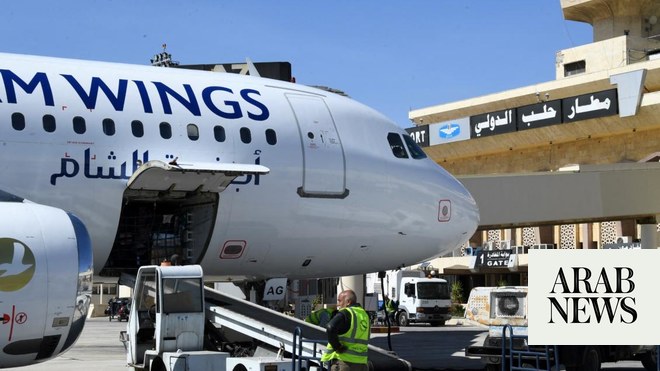Israeli strikes knock out Damascus, Aleppo airports: Syria state media

[ad_1]
GAZA: Gaza’s children are showing ever more signs of trauma two weeks into Israel’s intense bombardment, parents and psychiatrists in the tiny, crowded enclave say, with no safe place to hide from the falling bombs and little prospect of respite.
Children make up about half of Gaza’s 2.3 million population, living under near constant bombardment with many packed into temporary shelters in UN-run schools after fleeing their homes with little food or clean water.
Israel is expected to launch a ground attack on Gaza shortly in response to a cross-border assault by Hamas fighters on southern Israel on Oct. 7 that killed more than 1,400 people, with a further 210 taken hostage.
“Children … have started to develop serious trauma symptoms such as convulsions, bed-wetting, fear, aggressive behavior, nervousness, and not leaving their parents’ sides,” said Gaza psychiatrist Fadel Abu Heen.
More than 4,100 Palestinians have been killed in Gaza so far, including more than 1,500 children, while 13,000 people have been injured according to the Palestinian health ministry.
Conditions in makeshift shelters in UN schools, where more than 380,000 people are camped out in hope of escaping the bombardment, only compound the problem.
There are sometimes 100 people sleeping in each classroom, which all require continuous cleaning. There is little electricity and water so bathrooms and toilets are very dirty.
“Our children suffer a lot at night. They cry all night, they pee themselves without meaning to and I don’t have time to clean up after them, one after the other,” said Tahreer Tabash, a mother of six children sheltering in a school.
Even there, they are not safe. Such schools have been hit several times, the UN has said, and Tabash has seen strikes hitting nearby buildings. When her children hear so much as a chair being moved, they jump in fear, she said.
“That lack of any safe place has created a general sense of fear and horror among the entire population and children are most impacted,” said Abu Heen.
“Some of them reacted directly and expressed their fears. Although they may need immediate intervention, they may be in a better state than the other kids who kept the horror and trauma inside them,” he said.
One house in Khan Younis, in the south of the enclave, is sheltering about 90 people including 30 under the age of 18, where they have to sleep in shifts for lack of space.
“When there’s an explosion or any target getting hit nearby they are always screaming, always frightened. We try to calm the younger ones, try telling them, ‘Don’t worry, it’s just fireworks’. But the older ones understand what’s going on,” said Ibrahim Al-Agha, an engineer sheltering in the house.
“They will need a lot of support mentally after this war finishes,” Agha said.
However, Gaza’s healthcare system was already over-stretched before this month’s war, which has pushed it to the brink of collapse, and mental health experts have long warned of the terrible toll that was already being exacted on children.
A 2022 report by aid group Save the Children found the psychosocial well-being of children in Gaza at “alarmingly low levels” after 11 days of fighting in 2021, leaving half of all Gaza children in need of support.
Mental health experts in Gaza have said there is no such thing there as post traumatic stress disorder because the trauma in the enclave is continuous, with repeated bouts of armed conflict stretching back nearly two decades.
Early on Saturday, after an Israeli airstrike destroyed a building in Gaza City, killing many of the Abo Akr family, a large group of children stood among those watching rescuers picking through the rubble for survivors and bodies.
As women nearby wailed and wept, the children stood watching, their faces showing nothing.
[ad_2]
Source: Arab News




